Heavy-Duty Connectors for Off-Highway Applications
Off-highway vehicles require heavy-duty connectors that can handle demanding power requirements, withstand the elements, and stay connected through the jostling and vibrations that this rugged category of vehicles experiences in the field.
Off-highway vehicles used for construction, agriculture, mining, or other demanding applications require connectors that differ significantly from those used in consumer vehicles.

Just like the equipment in which they are used, heavy-duty connectors must be built to be tough. They must be capable of handling high currents and loads while keeping a multitude of wires secure under conditions of high vibration, temperature extremes, and exposure to dirt, dust, and moisture. Designers must consider the unique demands of these vehicles and the characteristics available in heavy-duty connectors to specify the right components for off-highway applications.
Current Rating and Circuit Density
Be sure that your connector’s current rating corresponds to the current-carrying capabilities of the individual terminals used. Current rating is stated in amps per circuit (i.e., per terminal) and is a measure of the amount of current that can be passed through a mated terminal.
Using one connector per circuit isn’t practical for off-road vehicles, given the high number of circuits and limited amount of space available for wiring. Heavy-duty connectors are equipped to handle many circuits, allowing manufacturers and upfitters to be economical with the space at hand.
Circuit density — the relative measure of the number of circuits a connector can accommodate per square inch — can help you determine the space requirements or size of one connector family versus another. Aptiv HES (Harsh Environment Series) connectors, for example, offer high current capability and high circuit density.
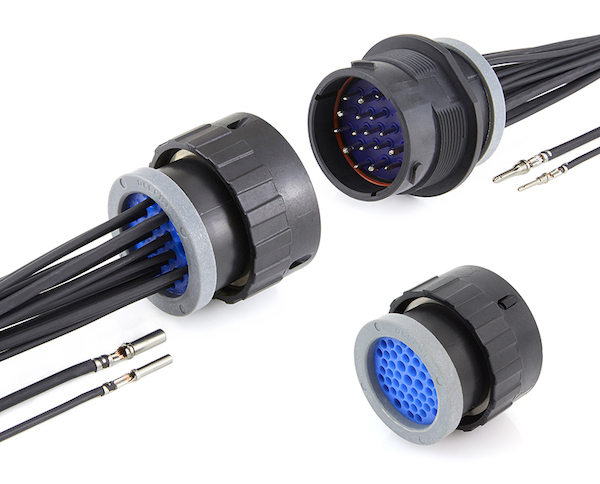
The Aptiv HES 47-Pin Connector, often used in agricultural machinery, has a high circuit density.
Locking and Engagement Force
Heavy-duty connectors will have a locking tab or retention system that is more robust than those found in typical automotive connectors. Heavy-duty connectors are made to withstand high engagement force and to stay connected when subjected to the vibrations of off-highway applications. Locking tabs will ensure — with an audible click — that the connection is secure. Some connectors include secondary locks inside. For off-highway applications, you should expect the external locking clip to be capable of handling an engagement force of up to 50 pounds.
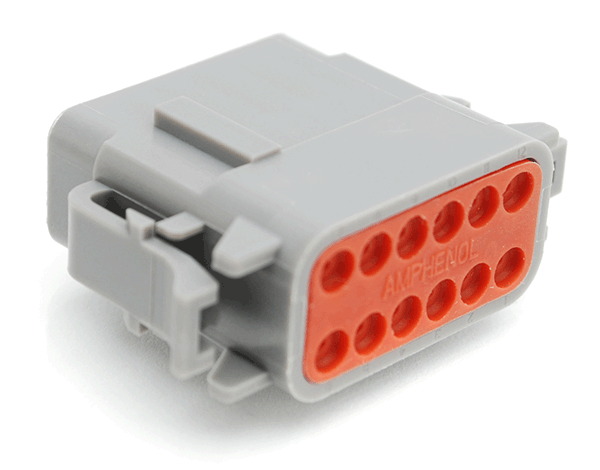
Amphenol Sine Systems 12-Way ATM Connector Plug with a locking tab can handle an engagement force of up to 89 pounds.
Specifications and IP Ratings
Ensure that your electrical connector system has been tested to a consistent specification with respect to other connector systems. Most connectors meet the requirements of UL, Society of Automotive Engineers (SAE), CSA Group, and numerous other certification agencies.
For connectors, ingress protection (IP) ratings and salt spray tests are particularly important, as they are indicators of the connector’s resistance to moisture and contaminants. Heavy-duty connectors are typically rated from IP65 to IP6K9K. An IP65 rated connector will be adequate for many off-highway applications, indicating the connector is sealed for protection from dust, oil, and other non-corrosive material. An IP6K9K-rated connector can withstand more extreme conditions, including high-temperatures and high-pressure water spray.
Strain Relief
Many heavy-duty connectors are built with extended housing that provides strain relief. Strain relief offers an extra degree of wiring protection and safety needed for many heavy-duty applications. Because the housing is extended, it provides more enclosure of the terminal and wire, preventing the wire from bending at the point where it meets the terminal.
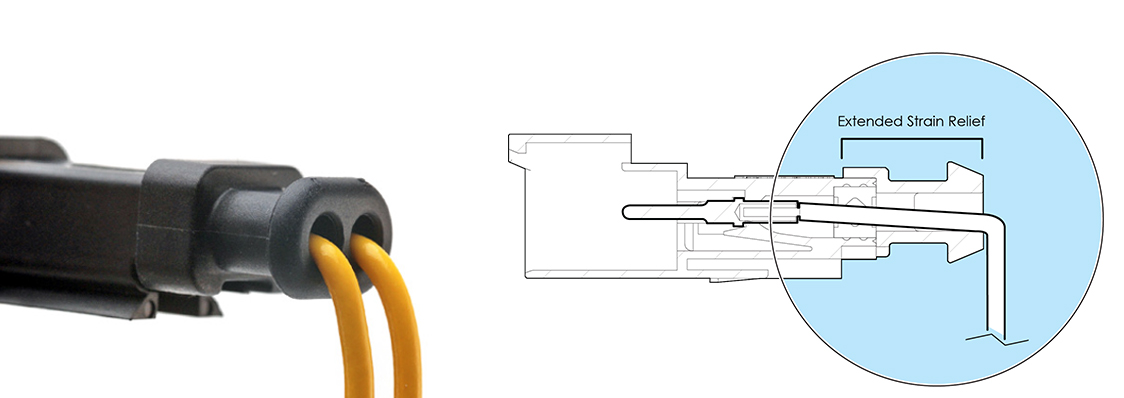
This illustration demonstrates the strain relief feature in an Amphenol Sine Systems AT-SR01 Series Connector.
Backshells serve a similar purpose as strain relief. Backshells are add-ons that are made to enclose an entire connector. The demand for backshells has diminished as more connectors are manufactured with strain relief built in.
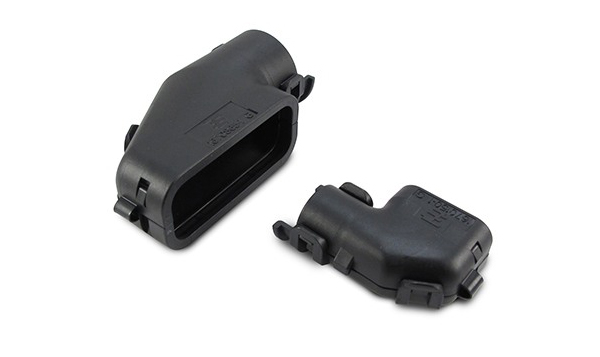
HDSCS backshells from TE Connectivity enclose the connector to offer protection from the elements as well as strain relief.
TPA and CPA
Many heavy-duty connectors feature terminal position assurance (TPA), which is an added clip on the back for additional strain relief. Others come with connector position assurance (CPA), a mechanism that makes sure wires don’t get damaged inside during the connection process. CPA assures alignment of the terminals and gradually slides over them when the halves of the connector are mated, locking into place to prevent accidental disconnection.
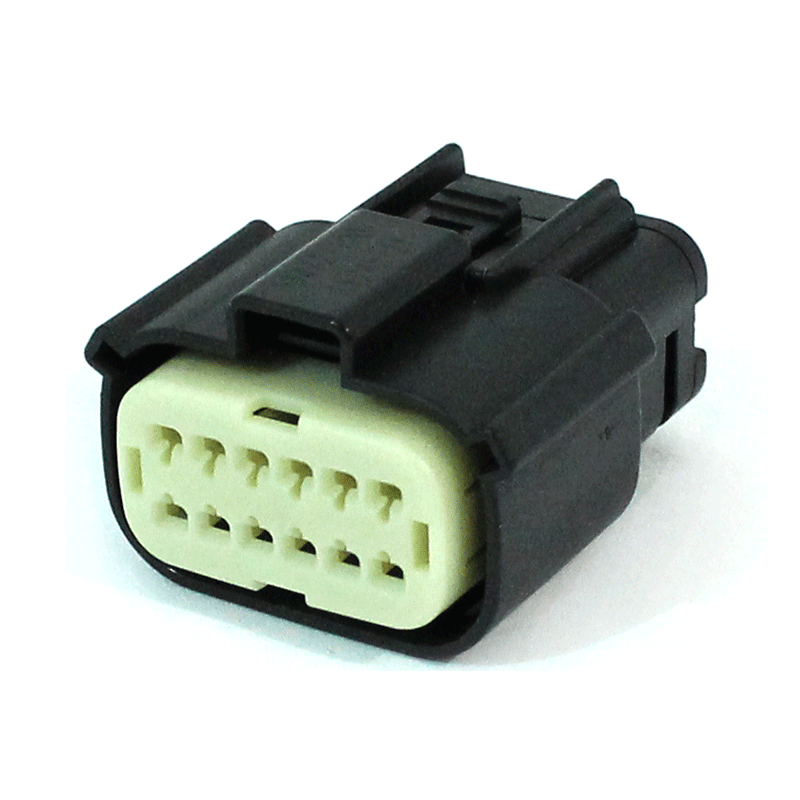
A Molex MX150 12-Pin Connector with CPA. The lighter-colored CPA mechanism aligns the terminals and gradually slides them forward when the connector is mated.
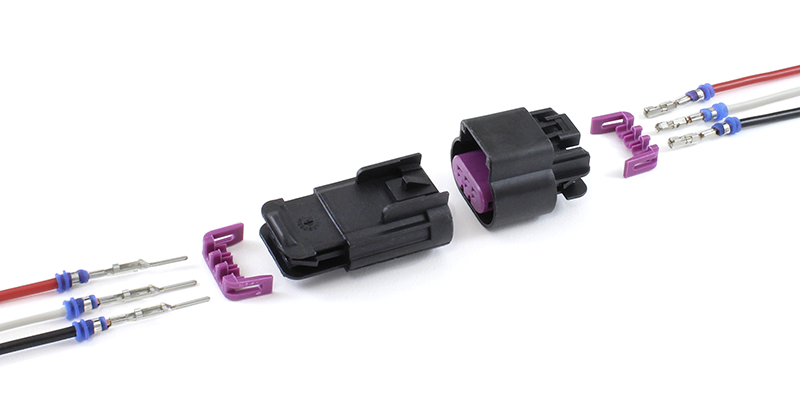
An Aptiv GT 150 Series connector, shown with TPA clips (in purple) for both sides.
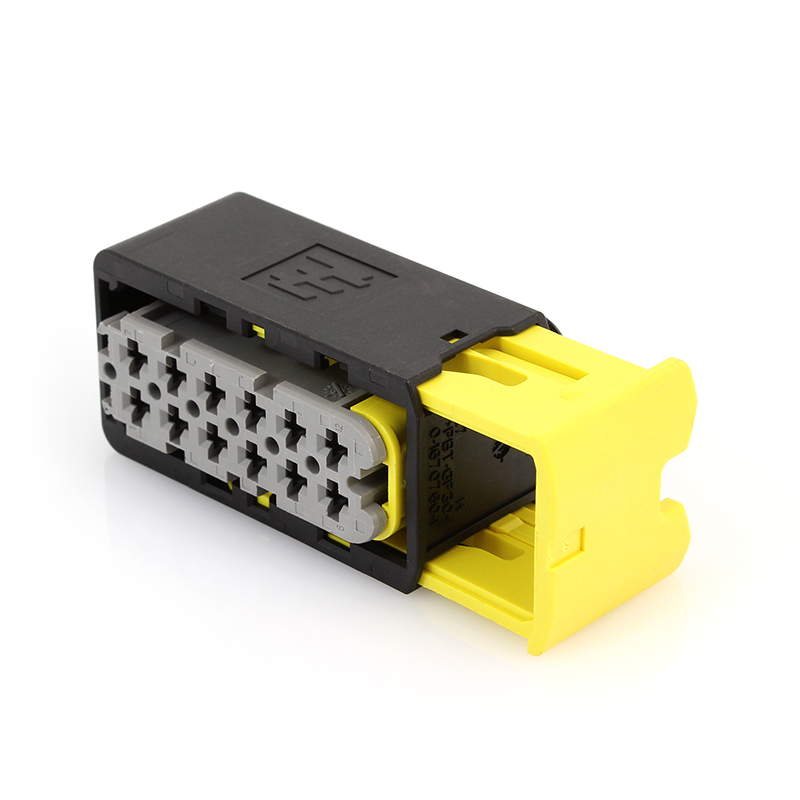
The HDSCS 12-Position Sealed Receptacle Housing from TE Connectivity features a side-locking mechanism (in yellow) and CPA (in gray) for contact alignment and retention.
Flammability Rating
The flammability rating of a connector’s housing material will be important for many off-road applications. Most electrical connectors are made from a nylon plastic typically with a flammability rating of either UL94V-2 or 94V-0. The higher 94V-0 rating indicates that the nylon will extinguish itself (in case of fire) more rapidly than the 94V-2 nylon. A 94V-0 rating does not infer a higher operating temperature rating, but rather a higher resistance to flame continuance. For most applications, the 94V-2 material is adequate.
Terminal Selection
Another factor to keep in mind is the terminal type used inside the connector. Terminals are plated with varying materials for varying needs. Tin and tin lead are appropriate for applications where each circuit ranges from 0.5A to 30A. Brass is an inexpensive material with high derating that offers a good combination of strength and current-carrying capabilities. Phosphor bronze is pliable, takes lower engagement force inside a connector, and is ideal for applications requiring high-temperature or high-cycle capabilities. Gold plated terminals, like the ones offered in the Deutsch DT-compatible Amphenol Sine Systems AT Connector line, are often specified for signal or low-current harsh environment applications.
Connectors with Built-In Busbars
A newer type of heavy-duty connector featuring built-in busbars has become popular for a variety of applications where a common bussed electrical pathway is required. One example is the Hyperbuss AT family of receptacle connectors from Amphenol Sine Systems. A single power source can feed into this connector and then, via the internal busing, be split to make as many as 18 connections, saving time and labor. Because the busing is inside the connector, it is sealed and protected from the elements.
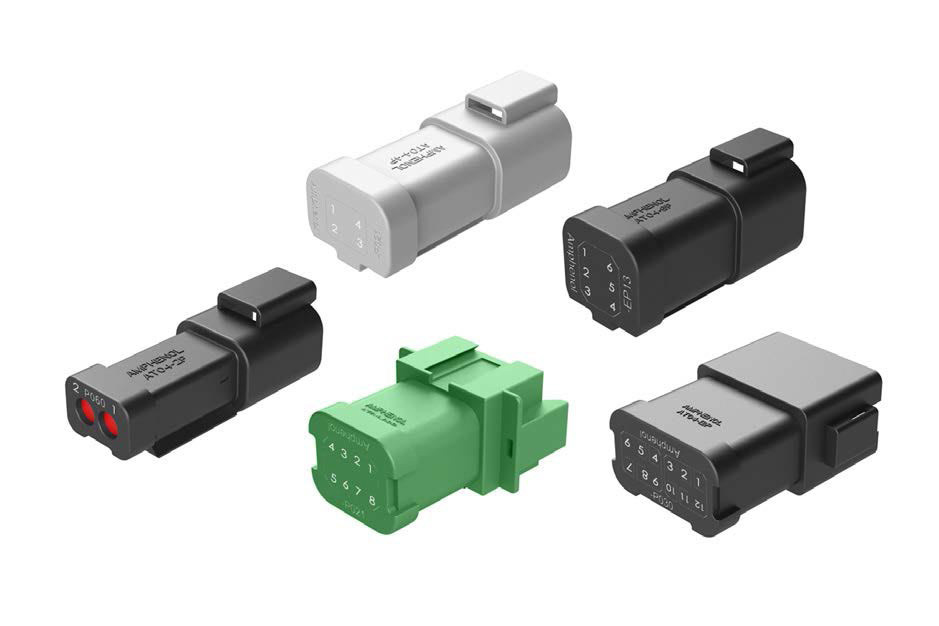
Hyperbuss connectors from Amphenol Sine Systems can be connected directly from a vehicle’s battery terminals instead of using individual terminals and bus bars, reducing wire harness size.
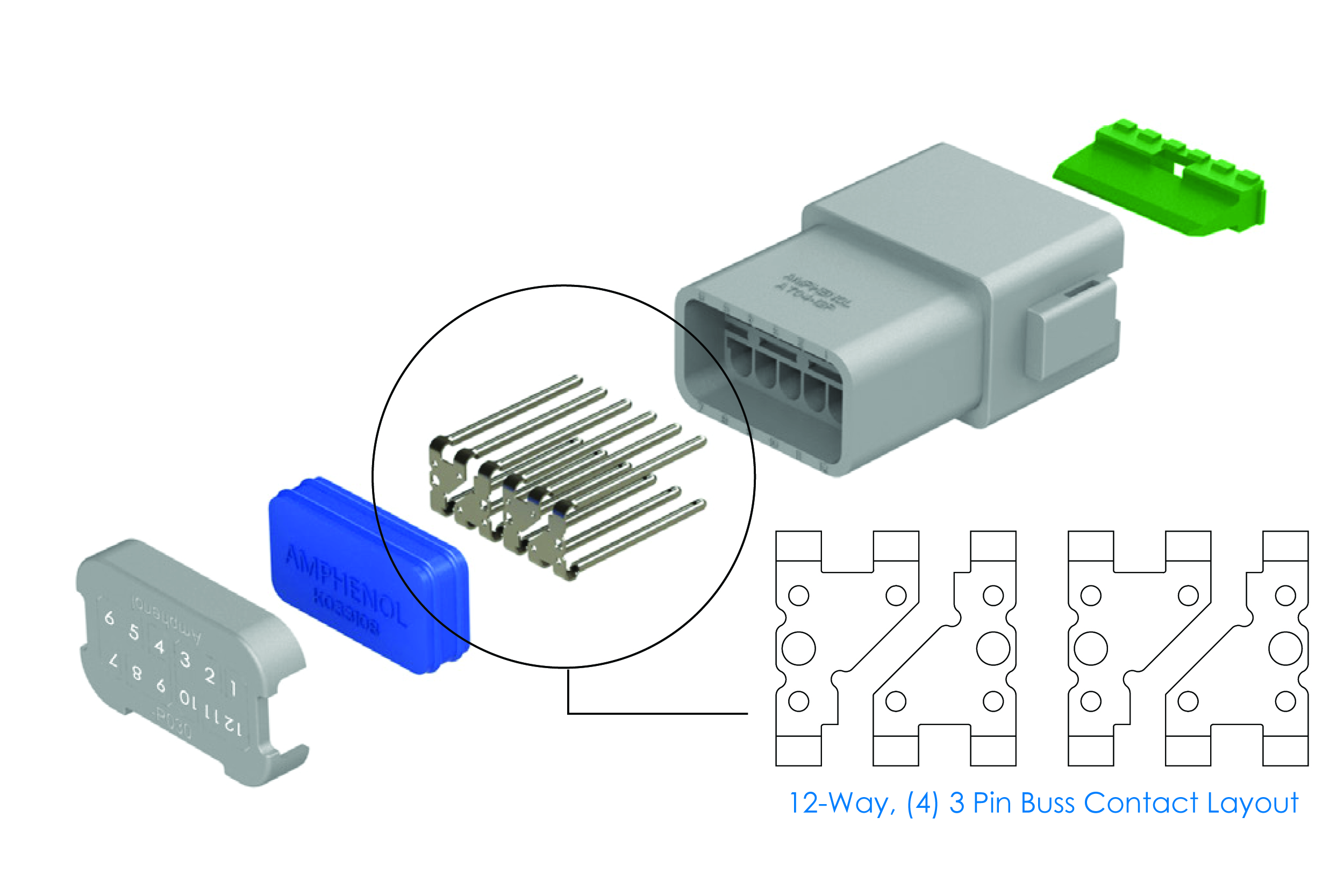
The internal bus bar & terminal assembly of an Amphenol Sine Systems Hyperbuss connector.
Whatever your off-highway wiring needs, look for connectors that are made to handle your unique power requirements and number of circuits, are built to withstand the elements, and will stay connected through the jostling and vibrations that off-highway vehicles experience.
Like this article? Check out our other Heavy Duty, Harsh Environment and Power articles, our Transportation Market Page, and our 2021 and 2020 Article Archives.
- Hybrid Connectors for Heavy-Duty Transportation - August 23, 2022
- CAN bus Connector and Cable Considerations - February 15, 2022
- Heavy-Duty Connectors for Off-Highway Applications - May 4, 2021





